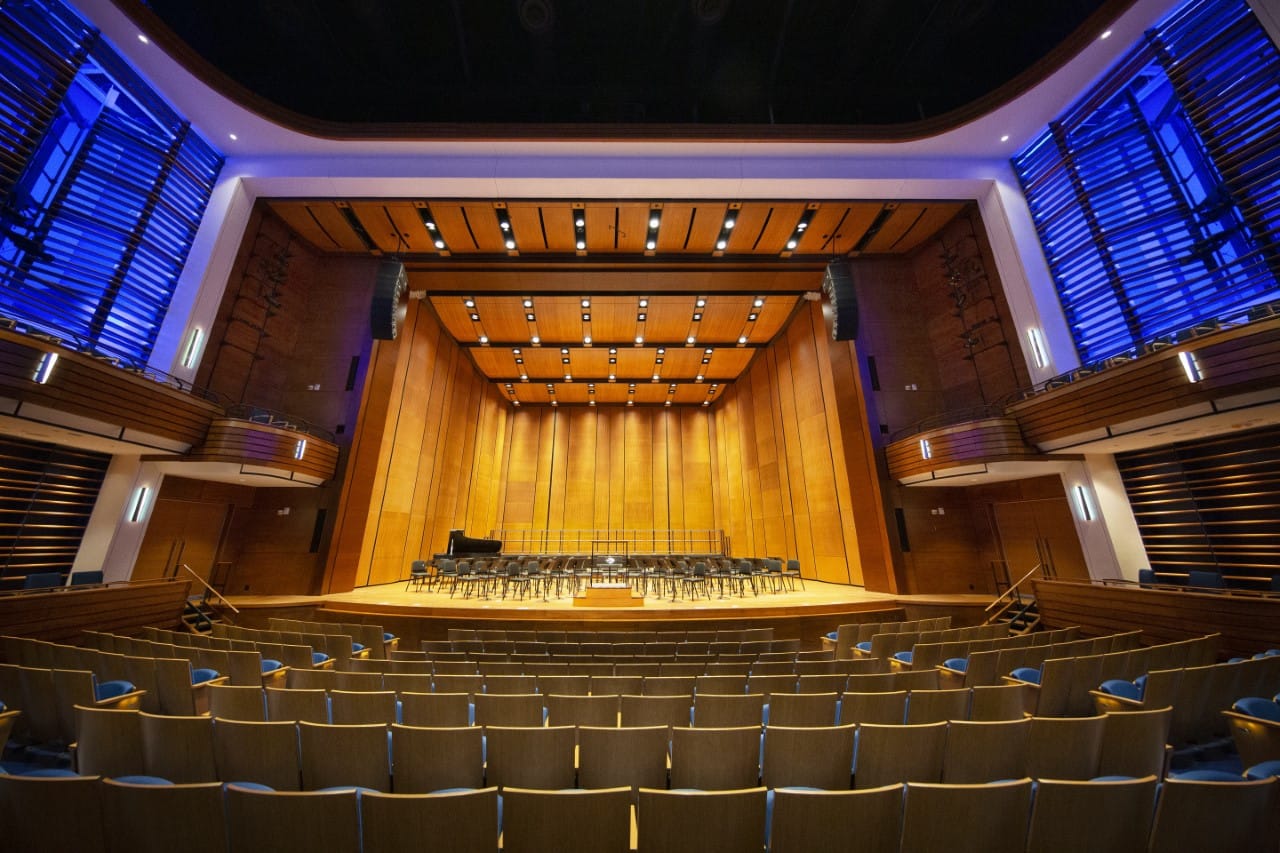 Wenger Corporation has announced the installation of a custom Diva Acoustical Shell at Auburn University’s new Jay and Susie Gogue Performing Arts Center at Auburn University in Auburn, Alabama.
Wenger Corporation has announced the installation of a custom Diva Acoustical Shell at Auburn University’s new Jay and Susie Gogue Performing Arts Center at Auburn University in Auburn, Alabama.
The focal point of the 85,000-square foot Gogue Center is the 1,202-seat Woltosz Theatre, which required superior acoustics to ensure every type of performance would be accommodated.
“This region has always had to drive to Birmingham, Atlanta or Columbus to have exposure to touring performing arts,” said Taylor Dyleski, director of Production at the Gogue Center. “Now, we get to bring that to experience to Auburn to make this an even better place to live and go to school.”
The team included Wilson Butler Architects, Akustiks Acoustical Consultants, Theatre Projects Consultants, Rabren General Contractors and Wenger Corporation.
The foundation is a custom Wenger Diva Acoustical Shell that would have the flexibility to serve all purposes.
“We’re connecting the sound on stage to the audience, and allowing the musicians to really hear themselves, hear each other and react to the room,” said Russ Todd of Akustiks.
Ten Wenger Transform Motorized Acoustical Banners line both house right and house left of the audience chamber. They have the ability to be individually controlled, so the user can lower or raise them to adjust the acoustics in the room. The banners are controlled by a J.R. Clancy SceneControl 12 Motion Control System.
“It’s very customizable and adaptable,” said Chris Burke, Production Manager for Audio at The Gogue Performing Arts Center. “The banners are great for our multi-purpose venue. If we have a classical artist, the banners can be up, so we get the best live sound possible. We can put them down for amplified shows where we need to absorb the acoustic energy in the space.”
A shell of this size would normally take hours to set up and strike, but Wenger’s engineers made it so three people can place the entire shell into performance position within 45 minutes and strike in just 20 minutes.
Auburn staff decided to add Wenger Lieto LED fixtures into the shell ceiling. They opted for Lieto White and RGBW, which adds the option for multi-colored lighting on stage.
The fixtures provide more lumen output than other fixtures currently used in acoustical shells, meaning fewer fixtures are required in the shell ceiling. They’re also silent, which is critical for performers on stage, much cooler than conventional lighting and dim down to zero percent. Plus, they’re easy to adjust, with three-axis beam positioning to provide tool-free pan, tilt and rotation, as well as the ability for front-face focusing.
“Usually with acoustical shells, you struggle with lighting the orchestra so they can see and be seen,” said Paul Anton, production manager in charge of lighting at the Gogue Center. “With this system, everything is incredibly well lit, the color is unbelievable, and we have a variety of options.”
“Now we have something up our sleeve for when we’re doing a Pops event or when we are presenting something unconventional in front of the shell,” Dyleski said. “We can do white light, and we can do a pop of color on top of that white light, and it won’t affect the musicians while performing.”
Though acoustics were a priority for the shell, it had to be beautiful and blend into the existing room.
“It was a little bit of a three-way effort,” said Josh Stiling, Senior Associate Architect at Wilson Butler Architects. “We hit the ground running with the theatre consultant and acoustician. We had a great history with Akustiks and Theatre Projects and collaborating early was critical. The process involved several iterations and design reviews.”
Kelly Chiaradonna, interior designer at Wilson Butler Architects drew inspiration for the look of the shell from local materials. She used southern heart pine in both lighter and darker stains for the veneer of the shell.
The forestage reflector ceiling was designed to match the over stage orchestra shell ceiling’s design, so it appears to be a single, seamless ceiling. The forestage reflector is suspended from a motorized hoist, which allows the users to adjust the angle of the forestage ceiling reflector.
The shell towers work well since theatre staff can move them around more easily, breaking them down in under an hour. The user has control over the curvature of the panels and depths of recesses in the shell ceilings.
“It was very fluid working with this team because everyone knows where their strengths are, and we knew what to expect from each other,” said Stiling. “This was a very collaborative design.”








